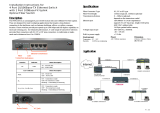Table of Contents
i
CHAPTER1.IN
TRODUCTION .................................................................................................................................... 7
1.1GENERAL ......................................................................................................................................................................7
1.2FUNCTIONALDESCRIPTION ...............................................................................................................................................7
1.3TECHNICALSPECIFICATIONS............................................................................................................................................10
1.4E1SIGNALSTRUCTURE..................................................................................................................................................13
1.5T1(DS1)SIGNALSTRUCTURE .........................................................................................................................................13
1.6APPLICATIONS/CAPABILITIES .........................................................................................................................................14
CHAPTER2.INSTALLATION .................................................................................................................................... 15
2.1GENERAL ....................................................................................................................................................................15
2.2SITEPREPARATION .......................................................................................................................................................15
2.3MECHANICALASSEMBLY................................................................................................................................................15
2.4ELECTRICALINSTALLATION..............................................................................................................................................16
2.4.1Powerconnection.............................................................................................................................................16
2.4.2RearandFrontpanelconnectors .....................................................................................................................17
2.5REMOVAL/REPLACEMENTPROCEDURES ...........................................................................................................................18
2.5.1SFPRemoval/Replacement(HotSwappable) .................................................................................................18
2.5.2TopcoverRemoval/Replacementforinternalaccess.....................................................................................19
2.5.3SNMPFeatureRemoval/Replacement ...........................................................................................................20
CHAPTER3.CONSOLEOPERATION ......................................................................................................................... 21
3.1INTRODUCTION ............................................................................................................................................................21
3.2TERMINALMODEOPERATION ........................................................................................................................................21
3.3CONNECTINGTOTHEFIBERMULTIPLEXER .........................................................................................................................22
3.4CONFIGURINGINCONSOLEMODE...................................................................................................................................23
3.4.1Login.................................................................................................................................................................23
3.4.2MainMenu.......................................................................................................................................................23
3.4.3DeviceConfigurationMenu..............................................................................................................................24
3.4.4PasswordConfigurationMenu.........................................................................................................................25
3.4.5AlarmConfigurationMenu...............................................................................................................................26
3.4.6OrderWire........................................................................................................................................................26
3.4.7StoreParameters..............................................................................................................................................27
3.4.8AggregateConfiguration..................................................................................................................................28
3.4.9OpticalLoopBack.............................................................................................................................................29
3.4.10E1/T1ModeConfiguration(RJ45modelsonly)..............................................................................................30
3.4.11E1(T1)Configuration .....................................................................................................................................30
3.4.12LANPortConfiguration ..................................................................................................................................32
CHAPTER4.WEBBASEDOPERATION ..................................................................................................................... 35
4.1GENERAL ....................................................................................................................................................................35
4.2TCP/IPCONFIGURATION...............................................................................................................................................35
4.3BROWSERLOGIN..........................................................................................................................................................35
4.3.1PanelDisplay ....................................................................................................................................................36
4.3.2Configuration ...................................................................................................................................................37
4.3.3TCP/IPConfiguration........................................................................................................................................38
4.3.4DateandTimeConfiguration ...........................................................................................................................38
4.3.5SNMPManagerConfiguration .........................................................................................................................39
4.3.6SYSLOGConfiguration ......................................................................................................................................40
4.3.7LOGInformation...............................................................................................................................................41
4.4PROVISIONINGVIAWEB ................................................................................................................................................42
4.4.1DeviceConfiguration........................................................................................................................................42
4.4.2OpticalConfiguration .......................................................................................................................................43
4.4.3E1/T1Configuration .........................................................................................................................................44
4.4.4LANConfiguration ............................................................................................................................................45
4.4.5OrderWireConfiguration.................................................................................................................................46
4.4.6SFPInformation................................................................................................................................................47
4.5REMOTEMANAGEMENT................................................................................................................................................48





















